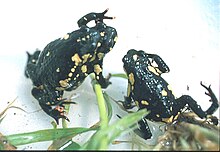| Melanophryniscus stelzneri | |
|---|---|

| |
| The name bumble bee toad comes from their distinct black and yellow pattern. | |
| Conservation status | |
 Least Concern (IUCN 3.1) | |
| Scientific classification | |
| Domain: | Eukaryota |
| Kingdom: | Animalia |
| Phylum: | Chordata |
| Class: | Amphibia |
| Order: | Anura |
| Family: | Bufonidae |
| Genus: | Melanophryniscus |
| Species: | M. stelzneri |
| Binomial name | |
| Melanophryniscus stelzneri (Weyenbergh, 1875) | |
| Synonyms | |
| |
Melanophryniscus stelzneri, commonly known as the redbelly toad, bumble bee toad or yellow and black walking toad, is a species of toad in the family Bufonidae which is endemic to Argentina. It is present in the pet trade.
Etymology
The specific name stelzneri honors Alfred Wilhelm Stelzner, a German geologist who spent some time in Argentina.
Taxonomy and subspecies
Melanophryniscus stelzneri was originally described in 1875. Currently two subspecies are recognized: Melanophryniscus stelzneri stelzneri and Melanophryniscus stelzneri spegazzinii Gallardo, 1961. Other former subspecies are now considered full species, namely Melanophryniscus dorsalis and Melanophryniscus fulvoguttatus.
Description
Melanophryniscus stelzneri grows to about 3.8 cm (1.5 in), with females typically being larger than males.

Distribution andhabitat
They were first discovered in Córdoba, Argentina. They are currently known from the Córdoba, San Luis, and Salta Provinces of Argentina. Their range may also extend into Bolivia. They occur in grasslands with rocky outcrops. Reproduction takes place in shallow ponds, streams, bogs, and even roadside ditches.
Diet and toxicity
Melanphryniscus are toxic in the wild. Their natural diet is made up of mites and ants. It is believed that the toxins are created from alkaloids found in their natural diet. The brightly colored pattern is an example of aposematism. In captivity, they become non-toxic.
Notes
- Many different common names are used in pet trade, and it is not always clear to exactly which species they refer to.
References
- ^ IUCN SSC Amphibian Specialist Group. (2023). "Melanophryniscus stelzneri". IUCN Red List of Threatened Species. 2023: e.T54831A101424343. doi:10.2305/IUCN.UK.2023-1.RLTS.T54831A101424343.en. Retrieved 4 April 2024.
- ^ Frost, Darrel R. (2024). "Melanophryniscus stelzneri (Weyenbergh, 1875)". Amphibian Species of the World: an Online Reference. Version 6.2. American Museum of Natural History. doi:10.5531/db.vz.0001. Retrieved 4 April 2024.
- ^ Beolens, Bo; Watkins, Michael & Grayson, Michael (2013). The Eponym Dictionary of Amphibians. Pelagic Publishing. p. 205. ISBN 978-1-907807-42-8.
- ^ "Bumble Bee Toad Care and Breeding". Josh's Frogs. Retrieved 4 April 2024.
- ^ "Yellow and Black Walking Toads (Melanophryniscus stelzneri)". Amphibian Care. Retrieved 4 April 2024.
- Weyenbergh (1875). "Apuntes Pequenos". Periodico-Zoológico (in Spanish and German). 1 (4). Buenos Aires: 331–333. Archived from the original on 6 July 2022 – via Google Books.
- De la Riva, Ignacio; Kohler, Jorn; Lotters, Stefan; Reichle, Steffen (2000). "Ten years of research on Bolivian amphibians: Updated checklist, distribution, taxonomic problems, literature and iconography". Revista Espanola de Herpetologia. 14: 19–164 – via ResearchGate.
- Hantak, Maggie M.; Grant, Taran; Reinsch, Sherri; Mcginnity, Dale; Loring, Marjorie; Toyooka, Naoki; Saporito, Ralph (2013). "Dietary alkaloid sequestration in a poison frog: an experimental test of alkaloid uptake in Melanophryniscus stelzneri (Bufonidae)". Journal of Chemical Ecology. 39 (11–12): 1400–1406. doi:10.1007/s10886-013-0361-5. PMID 24190023. S2CID 533559.
| Taxon identifiers | |
|---|---|
| Melanophryniscus stelzneri | |